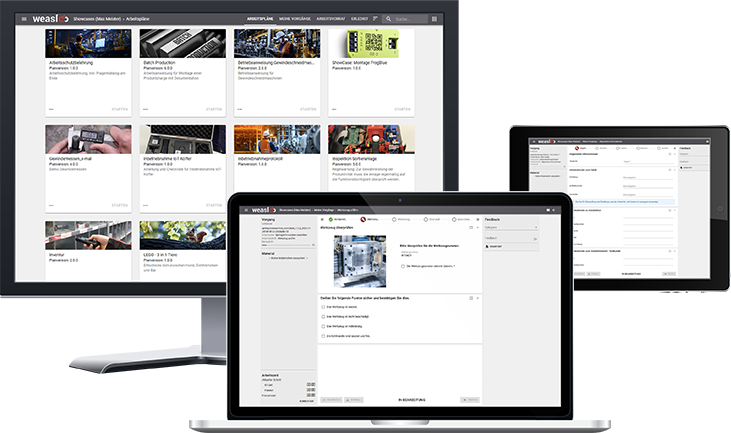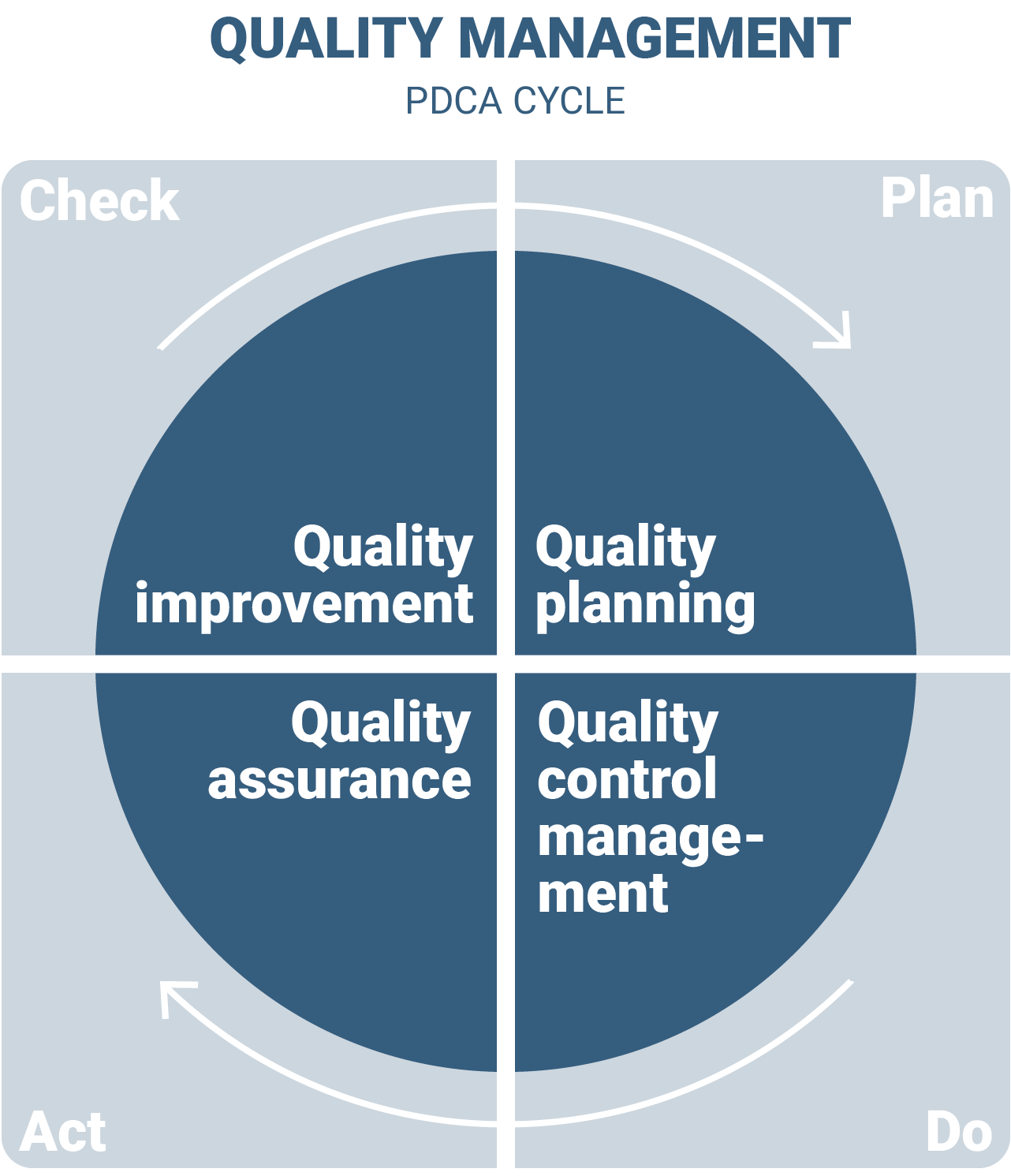Definition: What is quality management?
Quality management - or QM for short - encompasses all measures, management tasks and methods that serve to plan, implement, ensure, control and continuously improve processes, services or products. In a nutshell: quality management sets all the levers in motion so that a company can deliver products and services of the required quality on a permanent basis.
The practical implementation usually takes place via a quality management system (QMS), although there are no top dogs here like SAP for ERP or AWS for Cloud. The right system depends heavily on the industry, company size and requirements. For some industries, however, quality management systems (QMS) are required by law. These include
- aerospace
- automotive industry
- medical technology
- parts of healthcare and medical rehabilitation
- pharmaceutical and food manufacturing
There are now numerous established standards and models for the content and process design of quality management. These include, for example, ISO 9000 or the EFQM model - short for European Foundation for Quality Management.
.
Summary:
- quality management ensures and improves the quality of products, services and processes
- a quality management system is the practical tool for this
- ISO 9000 and EFQM are common QM standards
Components & steps of quality management
So quality management does everything it can to achieve the set quality target. Sounds like a mammoth task, but fortunately QM is not alone in this. Rather, it holds together the threads that come together from the individual sub-areas of quality management.
1. Quality planning
It all starts with a plan, which in turn is based on the current state of your company. This must first be recorded and evaluated. Once this is done, you can derive concrete measures for quality improvement.
2. Quality control management
Quality control now takes over. Its task is to put the planned measures into practice and to control and monitor their implementation.
3. Quality assurance
Quality assurance is already close to the actual production. It bundles the organizational and technical measures that are necessary to ensure the required product quality.
4. Quality control
This is where the practical part comes in - quality control. Its task is to carry out tests during production or assembly. It checks whether the product has been produced in accordance with the specifications and thus evaluates the product quality.
5. Quality improvement
Quality improvement collects findings from all areas and analyzes them. It derives and implements optimizations and thus contributes to continuous improvement processes.
Summary:
- quality planning: analyze the current status and derive measures
- quality control management: implement, control and monitor measures
- quality assurance: bundles organizational and technical measures
- quality control: inspections and assessments during production
- quality improvement: evaluating and continuously optimizing findings
What are the benefits of quality management?
Once quality management and all its components are functioning smoothly, the biggest advantage is certainly the consistently high quality that your company can ensure. However, there are also a number of side effects:
- High quality means competitive quality. With effective QM, you will be able to withstand quality competition.
- QM measures focus on risks and errors. And you systematically minimize these through quality management.
- High quality requires structured processes and sustainable documentation. This leads to increased employee satisfaction.
- An established QM ensures efficient processes that result in noticeably reduced costs.
- High quality inspires your customers in the long term and strengthens customer loyalty.
Summary:
- increased competitiveness and customer loyalty
- risk minimization and error prevention
- higher employee satisfaction and lower costs
Core tasks of quality management
Quality needs a broad basis where everything has to fit. The tasks of quality management are correspondingly diverse. They range from documents and processes to complaints. Let's take a closer look at the details:
- Supplier management: Quality starts with your suppliers. You select suitable suppliers according to your criteria and objectives, evaluate them and, if possible, develop them further in line with your objectives.
- Document management: Documentation is everything. Both your specifications and all necessary evidence must be documented and managed appropriately.
- Test equipment management: To control quality, you need the right test equipment. And this also needs to be managed, calibrated and monitored.
- Risk management: Do you know where potential risks lurk in your processes? You can find out exactly that in risk management. You identify and evaluate risks with the help of an FMEA (Failure Mode and Effects Analysis), for example.
- Knowledge management: It sounds trivial, but company-relevant knowledge must be collected, structured, maintained and made available. This is also the task of quality management.
- Complaints management: It will probably never work without complaints. This makes it all the more important to have a sustainable complaints management system that handles customer complaints and complaints against suppliers and promotes the reduction of internal complaints.
- Process management: With your quality goals in mind, you plan, control and optimize your company processes.
- Validations and process capability studies: Are your processes running smoothly and reliably? Can processes be reproduced? Quality management also deals with these questions, their answers and the associated measures.
- Improvement management: The status quo can always be improved. Continuous improvement processes (CIP) are an essential part of quality management. This also includes the management of appropriate measures - for example via CAPA (Corrective and Preventive Actions).
- Management reporting: Behind all measures are key figures that must first be defined and then recorded and evaluated. The actual values can then be compared with the targets.
- Auditing: The quality management system must also be regularly put to the test. You can do this through internal and external audits.
Summary:
- selecting suitable suppliers and systematically documenting all QM requirements
- identifying risks and optimizing company processes
- handling customer complaints and continuous improvement processes
- managing test equipment and providing structured knowledge
- evaluating key QM figures and conducting regular audits
Goals of quality management
So does quality management automatically lead to ever higher quality results? The answer is: No. The aim of quality management is not to constantly revamp processes and standards in order to achieve a little more quality. Rather, quality management is based on clearly defined, targeted quality objectives.
And this is precisely what QM must ensure. To this end, standards and requirements are defined in advance and quality management ensures compliance with them. Within this framework, processes and procedures are continuously optimized in order to achieve the desired quality objectives.
Summary:
- ensuring defined quality targets through specifications and standards
- monitoring compliance with requirements in processes and procedures
- continuous optimization for sustainable target achievement, not for constant improvement
The shopfloor-related support for quality management
Quality management is not possible without the very practical work of quality assurance and quality control. And you can entrust these to your employees in manual production and assembly with a clear conscience - with weasl.
Experience how weasl supports your quality management - in our free showcase environment.


